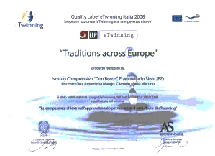Quante volte ci siamo sentiti dire dai nostri genitori o dai nostri nonni:” Ma che giochi fate, i nostri sì che erano giochi !”. Ora ci è venuto il desiderio di conoscere i loro giochi ed è per questo che abbiamo deciso di intervistare i nostri nonni per conoscere e riproporre a noi stessi il loro modo di trascorrere il tempo e il loro modo di divertirsi. Li abbiamo intervistati e ci siamo convinti che avevano ragione. Noi trascorriamo troppo tempo in solitudine davanti al televisore mentre loro stavano sempre in compagnia in mezzo alla strada, dalla mattina alla sera . Giocavano e si divertivano un mondo. I loro giochi erano coinvolgenti, spesso pericolosi, ma quasi sempre molto interessanti, da tutti i punti di vista, in quanto erano giochi che prevedevano fantasia, intelligenza,tattica, abilità, resistenza e persino creatività. Già, perché il più delle volte erano loro stessi che dovevano costruire i loro giocattoli, dal monopattino alla carrozza, dalla fionda all’arco con le frecce, dal pallone costruito con staccë al ruòllë, ecc. Noi abbiamo provato a rifare i loro giochi e abbiamo constatato che erano davvero bravi nell’eseguirli. Li abbiamo rifatti nelle nostra palestra, con il tappeto in gomma, con le scarpe da ginnastica ai piedi, con il materasso per attutire eventuali cadute, e tuttavia abbiamo incontrato molte difficoltà. Essi, invece, li eseguivano in mezzo alla strada selciata, con ai piedi pesanti scarponi, senza tuta e soprattutto senza materassino per attutire delle cadute che sicuramente ci sono state.
How many times we heard to say to us by our parents or our grandparents: “But what games you play, ours, certainly, were games!” Now the wish to know their games was born in ourselves and that’s why we decided to interview our grandparents to know and repropose to ourselves their way to spent the time and have fun. We interviewed them and convinced ourselves that they were right. We spent our time in loneliness opposite the television as they always stayed in company on the road , from the morning to the evening. They played and had a lot of fun. Their games were captivating , often dangerous, but quite always very interesting, from every point of view, as they were games that provided fantasy, intelligence, tactic, ability, resistance and even creativity, Yes, because the more of the times they had to make their toys for themselves, from the scooter to the carriage, from the catapult to the bow with the arrows, from the ball made with the “staccë”( flat stones) to the “ruòllë” (tumble), etc. We tried to replay their games and realized they were really good at playing them. We replayed them in our gym, with the gum carpet, with the trainers at our feet, with the mattress to cushion the falls, and all the same we had many difficulties. They, instead, played them on the paved street, with at their feet heavy boots, without track suit and moreover without mattress to cushion the falls that surely there have been.
I questa presentazione, da noi realizzata, tutto ciò che abbiamo trovato/ In this presentation, made by ourselves, all what we found out:
Our grandparents’games and toys in Francavilla
In questi filmati, anch’essi realizzati da noi, tutti i nostri giochi in palestra/In these videos, also made by ourselves, all our games in the gym:
foto / Photos
Video 1
Video 2
La musica, nella presentazione ed in uno dei video, è suonata con strumenti tipici del nostro artigianato locale: fischietto, zampogne e totarella.
The music, in the powerpoint and in one of the videos, is played with typical instruments of our local handicraft: whistle, bagpipes and “totarella” ( a kind of recorder).


Zampogne / Bagpipes Totarella / Recorder
Guarda anche su / Also look at sulsinni.com
Mario, Gina e la classe 5^B- Scuola Primaria “A. Ciancia” – Francavilla in Sinni (PZ) – Italia





























































Recent Comments